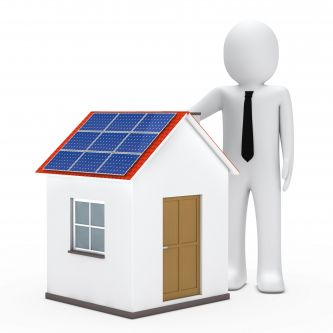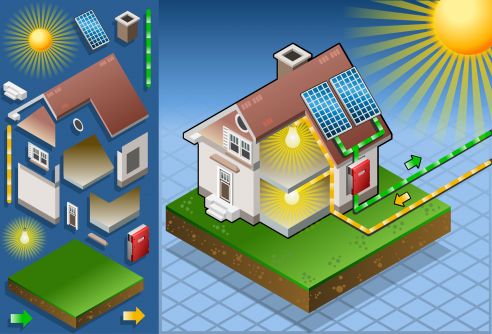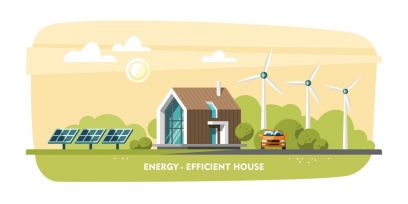How Do Rooftop Solar Panels Work New Jersey
How do rooftop solar panels work for your home?
Solar panels are devices that convert solar energy into electricity. There are several different kinds of solar panels, but they all use the same basic concept. Photovoltaic cells in rooftop solar panels absorb sunlight and release voltage as photons hit them, causing electrons to move within them, producing an electric current. This electric current can power homes and businesses.
Solar panels on your home absorb sunlight and turn it into electricity. Solar panels produce more electricity than a household needs when the sun is out to send excess energy back to the grid. You will use power from the utility grid like everyone else at night or when there is less sunlight (such as during cloudy weather); however, you can have extra power stored in batteries for later use.
If you end up producing more energy than your home needs, the excess power will be sent back to the utility grid and credited on your next bill. As long as there is any solar energy that your home cannot use, it will automatically go back to the grid, meaning you are paid for everything you produce.
Here are some things to think about while selecting where to put your solar panel system for maximum energy production.
Solar panel orientation:
When considering where to place solar panels, you must consider the direction of the sunlight and seasonal changes. Your roof is not always oriented in a way that allows for maximum sun exposure throughout the year. You can research online what time of day and on which days the sun shines at its strongest in your location for more accurate solar panel placement.
Roof size
If you have plenty of space on your roof, you could place more solar panels there to receive more energy. If your roof is narrow or faces an opposite direction of the sun, then you will need to think about obtaining a ground mount system where the panels are placed horizontally instead.

Roof pitch:
The solar panel should ideally be orientated at an angle that is equal to the latitude of the location where it will be installed. In most cases, pitch angles between 30 and 45 degrees will suffice.
Roof material
Different types of roofs allow for different amounts of solar energy penetration. If your house has a metal roof with an opaque finish, there would be less surface area available for solar panels since there is less roofing material.
Aesthetics:
Solar panels are placed on the surface of roofs and sometimes along the sides to soak up as much sunlight as possible. If your house has a view or you do not want to see solar panels, you may want to place them less visible. But if you have plenty of space on your roof, then the aesthetics may not be such a concern for you, and it may make more sense to place solar panels in a location where they can soak up the most sun.
Access for maintenance:
When deciding where your solar panel system should be placed, you must think about access to your roof. If you cannot get up on your rooftop safely and efficiently, it will probably not be worth placing solar panels there, and you should look at other options. Some homeowners install solar panel systems on the ground or the roof of their carport if they do not have a flat garage roof.
How is solar energy converted into electricity?

The panels are activated by the sun
Solar panels, which are activated by the sun, are created using silicon cells. These cells are held together using aluminum framing that’s called “aluminized plastic.” Silicon is a semiconductor material with a high level of conductivity. Silicon semiconductors are used to make solar panels because they can convert light energy into electricity.
The cells generate an electric current. Current is what causes devices to operate. Electrons are negatively charged particles that flow through the device to activate it. Electricity, which is created by solar panels, converts electrons into energy. Electricity is a form of energy that can be utilized for personal use, lighting, operating equipment, charging electronics, and heating homes.
The electrical energy is converted
The electrical energy is converted to DC electricity with the use of a module. A DC power plant can convert the DC back into AC, which can be used in your home. The solar panels on most residential buildings are grid-connected. They don’t function as standalone electric grids, meaning that they’re connected to the public utility grid and send surplus power to the grid too.
If your solar panels are grid-connected, they’re linked to a meter measuring how much energy you produce and consume. The meter only runs in one direction, which calculates the net total of all electricity produced minus electricity consumed.
The converted electricity created by solar panels powers your home
Solar panels convert the sun’s energy into electricity, which is used to power your home. This electricity can also be stored in batteries for later use. Batteries make it possible for you to continue using electricity at night or when there is no sunlight. Batteries also help regulate the flow of electricity when using more power than is being produced by solar panels.

Net metering records how much electricity you use.
Net metering allows you to receive credit for any electricity sent back to the grid, a mandatory part of a solar power system. The meter is always running, but that doesn’t mean you’re being billed every time it runs. You are billed for your total monthly usage minus the credit received from sending excess power back to the utility grid.
How much electricity does a rooftop solar panel produce?
Producing electricity from a rooftop solar panel is the primary goal. One of the essential elements to consider when looking at how much electricity can be generated by a rooftop solar panel is the orientation it’s mounted on and its size. The efficiency of a rooftop solar panel will depend on the direction and size of the module. It’s also essential that you don’t lose sight of the fact that not all residential buildings are equally conducive for their installation. A single solar panel might produce 250 watts per hour on average.
Rooftop solar panels can produce much more electricity than the average household needs, but it varies depending on local weather conditions and time of year. It is not uncommon for a rooftop solar panel to produce more than 100 percent of the household’s energy needs.
To calculate how much electricity that would be, you can find your monthly kWh on your electric bill and divide by 30 (for an average month) to get your daily kWh. Then multiply that number by the number of panels on the roof and divide by 1,000 to convert it into kilowatts. For example, if you have a 5kW rooftop solar panel array and your average monthly kWh consumption is 150, you would divide 150 by 30 to get 5. Then multiply 5 by 20 panels to get 100kW of capacity on your roof.

What can solar panels do for our environment?
People like the idea of being environmentally responsible and self-sufficient in their energy requirements.
Here are a few of the many environmental advantages of solar energy
- Solar panels reduce air pollution. Solar cells and solar modules don’t produce any emissions. The only emissions created by the solar panels are during the production of silicon and aluminum, which is a minimal amount.
- Solar panels do not use water. There are water-saving benefits to solar panels if you live in an area with limited access to clean drinking water. Solar panels don’t use any water to create electricity. Water is only needed when making solar cells and modules, which isn’t much water.
- It minimizes reliance on non-renewable energy sources. Solar panels reduce reliance on non-renewable energy sources. Solar energy helps lower our dependence on fossil fuels, which is an excellent thing for the environment.
- Solar panels provide clean and renewable energy. They don’t emit greenhouse gases, which reduces the impact of global warming. Solar panels also help improve human health in the long run by providing a healthier environment for all living things.
Frequently Asked Questions
Why is solar energy good for the environment?
Solar power is good for the environment because it reduces the negative impact of greenhouse gas emissions. These are gases that contribute to global warming, which significantly affects sustaining life on earth.
How much does it cost to install solar panels?
The actual costs of installing a solar panel system can differ based on factors such as the size and complexity of the installation. Solar panels typically cost between $15,000 and $25,000 to install.
How long does it take for a rooftop solar panel to pay off?
The time it takes for you to see the financial benefits of your rooftop panel is typically around 6-10 years for most homeowners. Some people might have enough money left after paying off their panels since they now have a new source of income with electric companies.
How much money can I save with rooftop solar panels?
It depends on many factors, from the amount you pay per kWh to your local weather conditions. A rough estimate is that you could see your electric bills decrease by as much as 50 percent.
Do solar panels make electricity when it is cloudy outside?
Yes, solar panels can still work if it is cloudy outside. Although they won’t produce as much electricity in darker conditions, there will still be a charge sent to your system when it’s foggy out. The main difference between the two is that you’ll have less electricity being processed.
What happens when a solar panel system produces more electricity than I need?
In most cases, you will have to sell the excess energy back to your utility company. In some states, your utility will cover certain installation and upkeep costs in exchange for access to your home’s power grid.
What is net metering, and how does it work with rooftop solar panels?
Net metering is a billing method that allows users to sell any extra electricity they produce back to their local electric company. It’s only available to people who own solar panels or wind turbines, but not all utility companies offer net metering.
How many solar panels would it take to power your house?
There is no exact answer for this because there are too many variables like how big or old the generator is, what size inverter you have etc. We can tell you that, on average, a 5-6 kW array will produce enough electricity to power an average-sized household with the electric company.
Summary – How do rooftop solar panels work?
Solar panels are devices that convert solar energy into electricity. Photovoltaic cells absorb sunlight and release voltage as photons hit them, causing electrons to move within them, producing an electric current. Solar panels have more electricity than a household needs when the sun is out to send excess energy back to the grid. Different types of roofs allow for different amounts of solar energy penetration. If your house has a metal roof with an opaque finish, there would be less surface area available for solar panels since there is less roofing material.
The solar panels on most residential buildings are “grid-connected” and don’t function as standalone electric grids. The converted electricity created by solar panels powers your home. Net metering allows you to receive credit for any electricity sent back to the grid, a mandatory part of a solar power system. A single solar panel might produce between 250 watts per hour on average.
